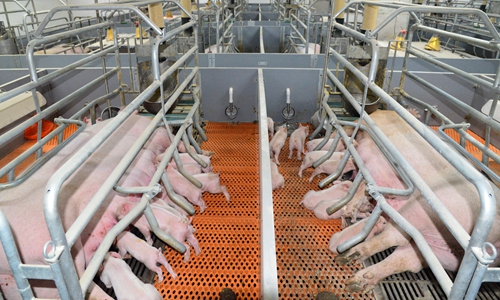HOME >> SOURCE
Halting hog disease
Source:Global Times Published: 2019/12/22 19:53:39
How China stems flow of African swine flu with innovations

A glance of sows breeding piglets in the hog building Photo: Courtesy of Yangxiang
As the Chinese New Year, which falls on January 25 approaches, pork goes into high demand as it is a common ingredient for the festival.But the African swine fever (ASF), a deadly hog disease, has caused mass slaughters of hogs in the country. China has adopted various methods in response to stably guarantee one of Chinese people's favorite meats, as pork accounts for 62.7 percent of country's meat consumption, the Xinhua News Agency reported.
China remains the world's largest pork producer and consumer, where hog production accounts for about half of the world's total.
To tackle poor hog production and stabilize the hog market, the Ministry of Agriculture and Rural Affairs has frequently issued policies and subsidies to support the industry. On Friday, it announced the country is allowing multi-floor buildings to breed animals.
Gao Yuanfei felt motivated by the newly-released policy. His company, Guangxi Yangxiang Co, in South China's Guangxi Zhuang Autonomous Region, is raising 30,000 hogs in four multi-floor hog buildings.
"Like metal buckets, our hog buildings are watertight," Gao, deputy CEO of Yangxiang, told the Global Times on Thursday, adding that no hog in the high-rise housings got infected by swine fever.
Pig hotels
Since August 2017, Yangxiang started to send hogs to the high-rise buildings with elevators. Breeding the hogs in enclosed spaces and filtering the air into the buildings, the company says it prioritizes strong biological safety under the current situation, said Gao.
Using the digital intelligent platform, Yangxiang is testing the concept of "Future pig farm (FPF)."
Giving the example of hog mating, Gao said conventional livestock companies rely on staff's breeding experiences to mate hogs, while FPF counts on big data.
"Based on the data collected by the sensors putting on sows, the staff would be reminded more accurately that it is the right time for sows to mate," Gao said the FPF has already shown better economic performance.
In 2018, Yangxiang's pigs per sow per year or "PSY", a key parameter of pig production, reached 28.8, much higher than China's average level at 22, it said. It added that the livestock's survival rate reached as high as 92.1 percent, with the cost of 10.54 yuan ($1.50) per kilogram.
Another advantage of such hog-raising methods is saving land. Gao noted that to produce 500,000 hogs requires a land area of 4,000 mu (266.67 hectares), while the multi-floor livestock only needs a land area of 400 mu.
However, Li Guoxiang, a research fellow at the Chinese Academy of Social Sciences, told the Global Times on Saturday that due to high pork prices, such methods can continue but may not survive in long term, because the cost of such hog raising methods might be high.
"Compared with the competitiveness of overseas pork prices, the problem of high cost of hog raising remains outstanding. China must find a way out to lower the hog raising cost," Li said.
According to the Ministry of Agriculture and Rural Affairs, the average price of pork in China was 51.21 yuan per kilogram on December 11, down 0.1 percent compared with the week before, but marking a 115.9-percent-growth year-on-year.
Bio-safety with blockchain
Another Hangzhou-based company, SMAIUN, in East China's Zhejiang Province can guarantee the bio-safety disposal of infected hogs with the help of blockchain technology.
The carbide cars developed by the company provide synergy supervision of the disposal of infected hogs, financial news site cfi.net.cn reported. The system would track the incineration of carcasses and provide reliable proof for farmers to ask for an insurance settlement claim with data recorded.
Traditional Chinese medicine
There are usually three methods to control ASF: control the infection source, cut off transmission routes and protect the susceptible hogs.
As the ASF vaccine is still not on the market, Chinese researchers and companies are working on feeding special fodder to hogs in order to enhance the immune response, said the national agricultural department.
Researchers at China Agricultural University and Beijing University of Agriculture have developed a pilot of feeding traditional Chinese medicine to hogs, instead of chemical antibiotics. The results are promising, according to researchers.
Chang Jianping, manager of Zhongyueminan (Beijing) technology development Co, a company on agricultural science development, told the Global Times on Friday that research showed the quality of pork has been hugely improved: cholesterol content in experimental pork decreased to half of the normal pork, and the amount of unsaturated fatty acids of tested pork reached three to six times compared with normal pork. These developments both led to better quality and healthier pork.
The Ministry of Agriculture and Rural Affairs said since 2020, it is not allowed to give growth-promoting medicines in feed additives except for traditional Chinese medicine.
In addition to revitalizing the domestic pork industry, China has increased pork imports.
Followed by progress on the phase one trade deal between China and the US, deputy head of Ministry of Agriculture and Rural Affairs confirmed on December 13 that China will enlarge pork imports from the US in order to stabilize the domestic market.
The US pork shipments to China reached the highest level in at least 10 months, totaling 5,940 tons in the week ended December 12, Reuters cited the data from the US Department of Agriculture on Friday.
Posted in: INDUSTRIES,BIZ FOCUS